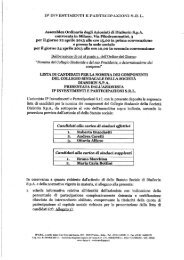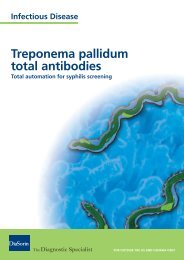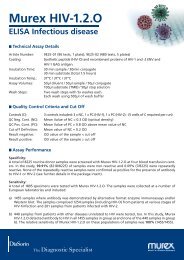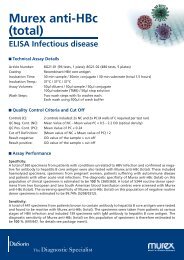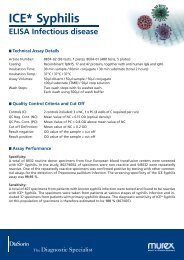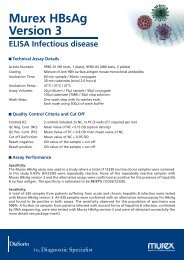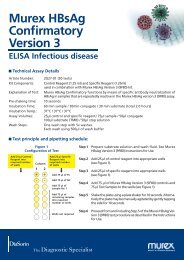Syphilis Booklet - DiaSorin
Syphilis Booklet - DiaSorin
Syphilis Booklet - DiaSorin
Create successful ePaper yourself
Turn your PDF publications into a flip-book with our unique Google optimized e-Paper software.
Fig. 4: Diagnosis of T. pallidum infection: positive direct observation<br />
The Infection is confirmed<br />
Treponemal Test ELISA<br />
or Chemiluminescence<br />
Reaginic Test<br />
RPR or VDRL*<br />
Treatment<br />
and monitoring<br />
Positive<br />
Positive<br />
Clinical stages<br />
Negative<br />
Negative<br />
Positive<br />
Negative<br />
Negative<br />
Positive<br />
Acquisition<br />
of baseline<br />
levels<br />
of reactivity<br />
Repeat one week later to observe<br />
seroconversion<br />
*These should always be titrated<br />
necessarily indicate re-infection or recurrence and<br />
correct clinical re-assessment is of primary<br />
importance. All tests can produce false positive<br />
results in healthy expectant mothers and<br />
doubtful reactivity in HIV-positive individuals. The<br />
challenge thus is to avoid false negative results.<br />
ELISA and chemiluminescence sensitivity and<br />
specificity are higher than for RPR, VDRL and FTA.<br />
The most frequently used strategies are RPR,<br />
VDRL or treponemal tests. The first option is a<br />
simple and inexpensive way of studying<br />
populations. The disadvantages are poor<br />
sensitivity in late-stage diseases and prozone<br />
reactions in early-stage infections. The second<br />
option is preferred because of its greater<br />
sensitivity; though it can produce false-positive<br />
results in cured patients, one advantage being<br />
that tests can be automated. We recommend<br />
identifying a grey zone between the 0.9 and 1.1<br />
indices, though this should be adjusted according<br />
to the population analysed.<br />
3.2. Disease diagnosis<br />
3.2.1. Primary syphilis in adults<br />
It must be stated that untreated patients can also<br />
present negative serological results even several<br />
weeks after the onset of chancre. Ensuring that<br />
direct diagnostic tests are carried out during this<br />
period is therefore vital. Any pattern of<br />
serological results is possible in a primary<br />
infection, depending on time elapsed. During this<br />
stage, IgG and IgM treponemal tests are positive<br />
in 99% of patients. TPHA is less sensitive than<br />
VDRL or RPR during this period and all those tests<br />
are less sensitive than ELISA and IgG/IgM<br />
chemiluminescence. If the disease is suspected to<br />
be at this stage, TPHA should thus not be the<br />
only test used, as a false-negative diagnosis for<br />
syphilis might result. Therapy during this period<br />
and the following stages can significantly alter<br />
serological results (Cf. Table 13).<br />
19



